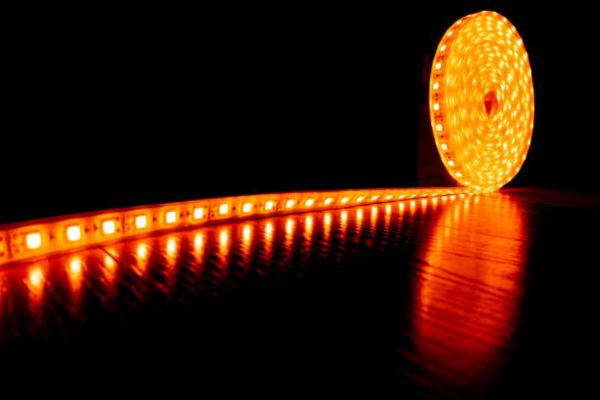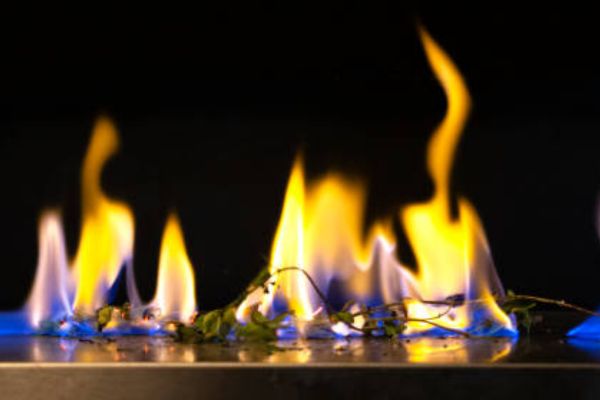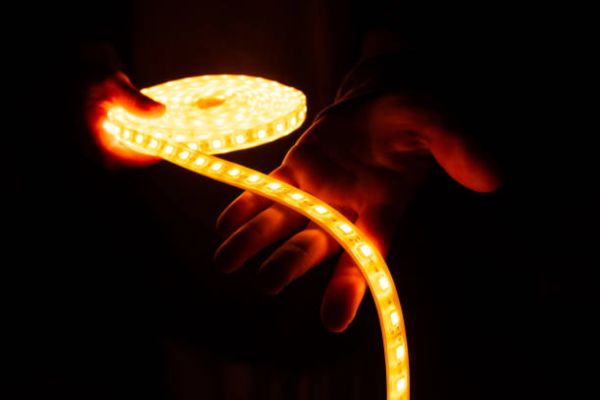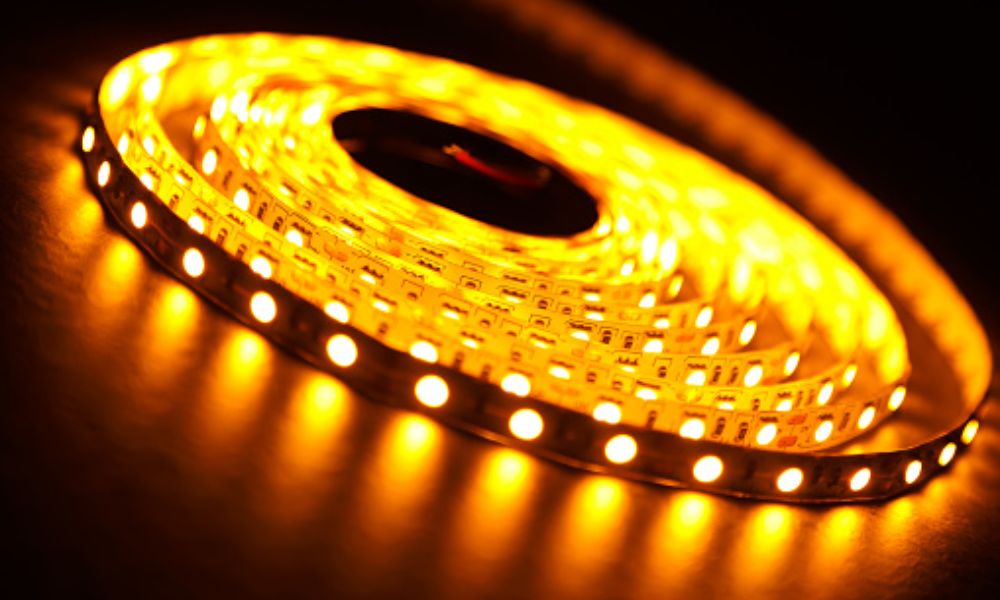I still remember setting up my first strip of glowing lights. A thought hit me—can LED strip lights cause a fire? It was a fair worry. Old bulbs once burned so hot they could scorch shades or even start a fire.
Since then, I’ve tested many lights at home. Incandescent bulbs ran hot. LEDs stayed cool and safe most of the time. Along the way, I learned when LED lights can start a fire and when they are safe to use.
In this guide, I’ll share what I found—do LED lights get hot enough to start a fire, are LED strip lights safe, and how they stack up against old bulbs. I’ll also share my own tips to keep your home safe.
By the end, you’ll know the truth about LED safety. You’ll also feel sure about setting up your own cozy space without fear. Let’s dive in and clear the myths before you switch on your next strip.
Understanding How LED Strip Lights Work
LED strip lights may look fancy, but the way they work is quite simple. Instead of burning a filament like old bulbs, LEDs use semiconductors to create light. This process gives off very little heat, which is why LED lights are known for being safe and energy-efficient.
When you compare them to incandescent or halogen bulbs, the difference is huge. Old bulbs can get hot enough to burn your skin or even ignite fabric if left too close. LEDs, on the other hand, stay warm at most but never reach dangerous levels.
ke incandescent or halogen bulbs, LEDs don’t get hot enough to start a fire under normal use.
I made the switch to LED lights a few years ago, and the change was more than just lower energy bills. I felt safer leaving them on overnight, and I no longer worried about lampshades or curtains getting too close. For me, LEDs turned out to be the smarter and safer choice for both style and peace of mind.
Do LED Lights Get Hot Enough to Start a Fire?

The simple answer is no—LED lights do not get hot enough to start a fire under normal use. Unlike traditional bulbs that burn at very high temperatures, LEDs give off only a small amount of warmth. That’s why they’re far safer for everyday use.
Incandescent and halogen bulbs can reach several hundred degrees, which is why touching them feels like touching a stove. LEDs work differently. They release most of their energy as light, not heat, so even after hours of use they stay cool compared to old bulbs.
That said, overheating can still happen if the setup isn’t right. Poor-quality strips without proper heat management, using the wrong power supply, or sticking them in places with no airflow can all cause problems. In rare cases, this can even damage the strip or melt the adhesive.
Out of curiosity, I once left my own strip lights on for an entire weekend. When I touched them, they were only slightly warm—nothing like the burning heat I used to feel from desk lamps. That small test gave me the confidence to use them daily without worry.
Can LED Lights Start a Fire?

The short answer is yes, but only in rare cases. LED lights are generally safe, but certain mistakes or poor-quality products can turn them into a risk.
One big factor is cheap or low-quality manufacturing. Not all LED strips are made the same. Knock-off brands may use poor wiring, thin insulation, or uncertified adapters. These shortcuts increase the risk of overheating and, in worst cases, fire.
Installation mistakes are another cause. Using the wrong voltage adapter, daisy-chaining too many strips, or overloading a circuit can all push LEDs beyond their safe limits. When that happens, wires and connectors can heat up much faster than expected.
Even placement matters. Sticking strip lights directly onto wood, paper, or fabric without airflow may trap heat. While LEDs don’t get as hot as old bulbs, poor ventilation can still build up enough warmth to damage the surface.
I once saw this happen to a friend. They used a mismatched power adapter with their strip light. Within hours, the adapter overheated, and part of the strip began to melt. Thankfully, it didn’t spread to the wall, but it was a wake-up call about cutting corners on safety.
Are LED Strip Lights Safe?

Yes, LED strip lights are safe when used properly. They’re designed to use less energy, give off less heat, and last much longer than old-school bulbs. That’s why so many people (myself included) now use them for everything from under-cabinet lighting to cozy bedroom vibes.
But not all LED strips are created equal. Some cheaper ones cut corners and skip safety testing. That’s why I always look for UL-listed or ETL-certified products. These labels mean the product has passed real safety checks. If it doesn’t have one, I skip it.
Installation also matters. Always use the right power supply—one that matches the voltage and wattage of your strip. Using the wrong one can cause overheating or even a short.
Another tip? Never cover LED strips with cloth, paper, or plastic. Even though they don’t get super hot, trapped heat can still build up. Also, try to install them in places that get some airflow to help stay cool.
One little trick that helped me: I labeled all my power adapters. I once mixed up a 12V strip with a 24V adapter—luckily I caught it before damage happened. Now, every adapter in my setup has a label, so I know what goes where.
Can a Light Bulb Start a Fire?
Yes, a light bulb can start a fire, especially the older types like incandescent or halogen. These bulbs burn extremely hot—hot enough to ignite paper, cloth, or even plastic if placed too close.
I still remember burning my fingers on an old desk lamp in college. It was on for maybe 30 minutes, and when I reached over to adjust it—zap! It felt like touching a frying pan. That bulb could’ve easily scorched nearby papers if I wasn’t careful.
In contrast, LED lights don’t get nearly as hot. They use a different process to create light and waste much less energy as heat. Even after hours of use, my LED strip lights only feel slightly warm to the touch.
This cooler operation is one reason I switched to LEDs in almost every room. No more hot lamps, no more fear of fabric too close to a bulb, and definitely no more finger burns!
Practical Tips for Using LED Strip Lights Safely

If you want peace of mind, the first step is simple: buy from trusted brands. Look for UL or ETL listings on the box or product page. These labels mean the lights passed safety tests. No label? Skip it.
Next, don’t overload your power supply. Every strip uses watts, and if you connect too many to one adapter or outlet, it can overheat. The same goes for daisy-chaining strips beyond their rated limit.
Keep LED strips away from flammable stuff like curtains, cardboard, or paper. Even if they don’t get very hot, poor airflow plus cheap adhesive could cause issues. I always leave a little breathing room behind my strips.
If you want to go a step further, try using aluminum mounting channels. These metal tracks help spread heat and make the setup look sleek too. I used them behind my TV and under my kitchen cabinets—they really help.
Before I install any LED strips, I run through a personal checklist:
- Is the brand trusted and certified?
- Am I using the right power supply?
- Is the surface non-flammable?
- Is there airflow?
- Are adapters clearly labeled?
This 2-minute check has saved me from mistakes—and money
FAQs 3
Do LED strip lights overheat?
Not usually. LED strip lights give off very little heat. If they do overheat, it’s often because of bad wiring, poor ventilation, or using the wrong adapter.
How long can you safely leave LED strip lights on?
You can leave quality LED strip lights on 24/7 if they’re installed properly. Just make sure there’s airflow and you’re using the right power source.
What happens if you cut or reconnect LED strips incorrectly?
If cut or reconnected wrong, parts of the strip may not light up, or the whole thing could stop working. Always follow the manufacturer’s guide and use proper connectors.
Can LED strip lights cause problems with pets or kids?
Not usually. Most LED strips are safe, low-voltage, and cool to the touch. Still, keep cords and strips out of reach to avoid chewing or pulling.
Are outdoor LED strip lights safe in the rain?
Only if they’re rated waterproof (IP65 or higher). Indoor strips should never be used outside. Always double-check the IP rating before installing outdoors.
Conclusion
At the end of the day, LED strip lights are safe—as long as you choose quality products and set them up the right way. They run cooler, use less power, and bring life to any space without the fire risk of older bulbs.
Personally, I’ve used LED strips all over my home—from my bedroom ceiling to under my kitchen shelves—and I’ve never had a single safety scare. With proper care, they’ve been reliable, energy-saving, and worry-free.

